
| Home : ITU News magazine | ||||||||||||||||||||
Broadband services are now available in 145 economies, including many developing countries throughout central Asia and Latin America (Figure 1, lower chart). The rapid expansion of broadband markets is being shaped by growing demand for multimedia services, greater competition, providers’ pricing strategies and the increased speeds made possible through the development of infrastructure. In terms of subscribers, Asia still leads the world, with 41.1 per cent of the worldwide total, followed by the Americas with 30.7 per cent and Europe with 27 per cent (Figure 2). Four out of the top ten largest broadband markets are in Asia. The United States is the largest single market, home to nearly 38 million broadband subscribers, or 23.8 per cent of the world total by the end of 2004, followed by China with 25.8 million, Japan with 19.1 million and the Republic of Korea with 11.9 million subscribers. Table 1 shows broadband market data for the top 20 economies in 2004, ranked by broadband penetration per 100 inhabitants. The effect of price warsGrowth in subscriber numbers in the largest markets is attributable, in part, to the policy focus given to broadband (for example, Europe’s and Australia’s broadband strategies) and to “price wars” that have cut prices and slashed operators’ margins. Intense competition has driven down the prices of broadband access in Japan and the Republic of Korea, for example, to make them the lowest in the world, at under 10 US cents per 100 kbit/s (Table 2). In the United States, where cable subscribers still outnumber digital subscriber line (DSL) subscribers, DSL providers have been offering promotional discounts and customised “tiered services” to build market share. However, according to some analysts, cable providers have been reluctant to engage in price wars, and have instead responded by increasing bandwidth and standard download speeds.
There is a widespread perception in the industry that broadband prices are falling and indeed, for established markets, this is true. Analysis of the relationship between price and speed during 2003–2005 for the sample of 76 countries that had already launched services in 2003 shows that the median price halved from USD 11.27 per 100 kbit/s in 2003 to USD 5.35 per 100 kbit/s in 2005 (Figure 3).
Not everyone enjoys lower chargesHowever, there are two caveats. Firstly, the introduction of tiered services has complicated pricing plans and may in fact raise prices for unwary customers who choose unsuitable options. Secondly, while broadband is spreading to many developing countries, broadband access in these markets is often priced far in excess of the world average, including extremely expensive access through leased lines. In these countries, some providers may engage in premium pricing of sought-after advanced services, or may simply be labelling ISDN services as “broadband.” The most expensive pricing packages among the selection of offers analysed are to be found in Myanmar (USD 1247 per 100 kbit/s per month), Uganda (USD 1125) and Cameroon (USD 827). In mid-2005, six out of the top ten most expensive countries for broadband access worldwide were in Africa. DSL providers respond that higher prices are justified, as they are moving quickly to increase speeds and quality of service. However, price differences between countries greater than 1000 per cent are hard to justify. Getting fasterWhat is not in doubt is that speeds have increased. Average download speed has risen from 1.3 Mbit/s in 2003 to 4.1 Mbit/s in 2005. Although they may not in practice be available all the time (due to network conditions and congestion), maximum theoretical download speeds have increased steadily (Figure 3, lower chart). Two years ago, only providers in Japan and the Republic of Korea had popular offerings in excess of 4 Mbit/s, using DSL or cable modems. By 2005, providers in 20 countries offered packages to the general public at speeds above 4 Mbit/s. In the complex relationship between price and speed, customers in most countries are now getting a better deal than three years ago. However, providers’ focus on speed looks set to change. Broadband packages will become increasingly adapted to individual customers’ needs and lifestyles. The introduction of tiered services and entry-level packages is an initial step in this direction, but this is set to evolve into dynamic pricing packages tailored to particular user profiles, such as “gamers,” “window-shoppers,” “chatterers” and “music-lovers.” Increasingly too, DSL providers will try to position themselves as providing a “triple-play” service of voice, data and video communications.
The future could be “always on”Ultimately however, the real future for broadband may lie in its ability to provide the “always-on” capacity and speed that are necessary for increased object-to-object traffic volumes in a world of networked devices. ITU’s “Internet of Things” report examines the next steps in “always-on” communications, in which Internet services and applications will shift from being focused on people to concentrate on object-to-object communications. High-speed “always-on” access will be vital to automating transactions between or by objects and allowing them to happen instantaneously, without initiation or involvement by human users. However, by the time the Internet of things is fully developed, it is likely that broadband will look radically different, and be used in different ways, given the rapid evolution of these technologies.
|
||||||||||||||||||||
 Broadband markets pick up speed
Broadband markets pick up speed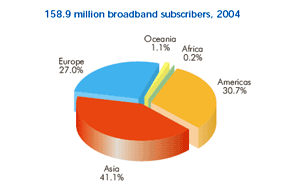
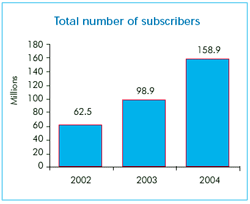
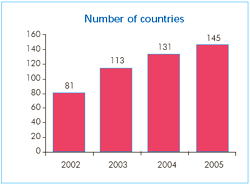
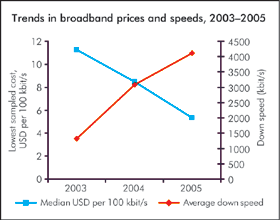
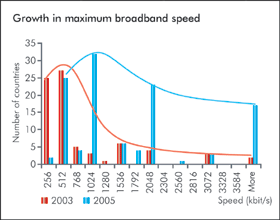
 People who enjoy shopping online are likely to be
targeted by broadband service packages that are tailored to their particular
needs. For example, they might put priority on unlimited access to the Internet,
rather than the high capacity favoured by people who use the system to play
online computer games with other fans
People who enjoy shopping online are likely to be
targeted by broadband service packages that are tailored to their particular
needs. For example, they might put priority on unlimited access to the Internet,
rather than the high capacity favoured by people who use the system to play
online computer games with other fans

